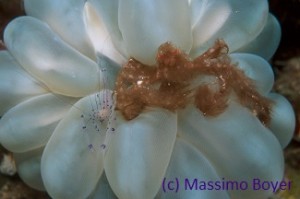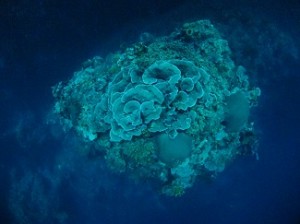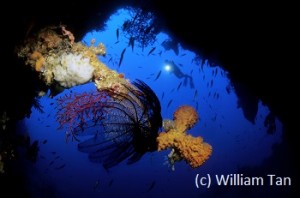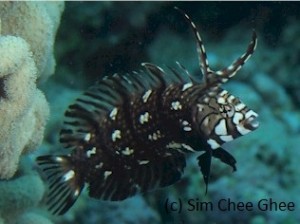Loading content - please wait...
Diving Sulawesi – Dive in Gorontalo

Gorontalo is an official home for the new Coleman’s coral shrimp (Vir colemani). Miguel’s Diving sent a few samples to the researcher. It was named in December 2003. This beautiful purple-jointed creature is common here. It is usually not found while diving Sulawesi’s other destinations.
Wall Diving
Diving Sulawesi includes its world-class coral walls. Those of Bunaken Marine Park in North Sulawesi are famous. Diving the walls of Bunaken is a thrill ride. Strong currents flow along the straight contour of its walls. In contrast, diving the walls found in Gorontalo is an entirely different experience. The forces of nature have left the limestone walls full of turns, buttresses, cracks, crevasses and caverns. We provide diving along the northern shores of Tomini Bay. Currents here are typically gentle. This gives divers a chance to explore the highly complex coral wall structures. The variety of marine life living in and around our coral walls is amazing.
Pinnacle Diving

Sulawesi is not known for its pinnacles. However, for those diving Sulawesi, one of the best dive sites in the Wakatobi area. A large pinnacle is found off Hoga Island. Gorontalo has many pinnacles. They rise from various depths. Their shape tends to be like a narrow giant pillar. They often stand in rows. Typically, they are found within several dozen meters of the main wall or slope. Divers can easily miss them without an experienced guide. There is also one pinnacle so large that Miguel’s Diving has named the site Sunken Island.
Diving Sulawesi’s Muck
No Sulawesi diving trip is complete without muck diving. This fascinating type of diving premiered in Sulawesi’s Lembeh Strait. The black volcanic sands there host wonderful and strange marine life. The sand in Gorontalo is mostly brown. A few dive sites have white sand.
Wreck Diving
Sulawesi is not known for wreck diving. However, the bomber wreck in the Togian islands is quite popular. Miguel’s Diving has discovered numerous wrecks in Gorontalo. We offer two historical wrecks to certified divers. The fifty-meter long Japanese Cargo Wreck sunk in 1942. It lies up-side-down in 26 to 50 meters of water. The smaller Tjenderawashi Barge Wreck sunk in a storm in 1993. It lies in four to 26 meters of water.
Cavern Diving

Sulawesi is not known as a location for either cave or cavern diving. However, one of Gorontalo’s signature dive sites is Jinn Caves. It is a gigantic cavern split at the top with two pinnacles inside. Many other dive sites have round open caverns at about 25 to 35 meters. These make great frames for underwater photographers. Diving all caverns in Gorontalo is non-technical. This means that divers always can see the exit. You do not need special training to enjoy the overhead environment.
Atoll Diving
Diving Sulawesi atolls is available in several destinations. There are smaller ones in the Togian Islands and the massive ones in the Wakatobi area. Miguel’s Diving offers one atoll. It is located along the shore. The dive site is variously called Coastal Atoll or Biluhu Ring. The atoll’s interior is full of jellyfish whose stings are fully functional. Just ask Miguel’s Diving staff! That is why we do not dive inside the atoll. The outer walls face into the heavy waves. Its upper ring is very rocky and has coral rubble in places.
Submerged Point Diving
One of the features of Gorontalo not found elsewhere while diving Sulawesi is submerged points. In Gorontalo, coral points jut from the wall at usually 35 to 40 meters in depth. They protrude into the long shore current. Schooling fishes gather at these points when the current is running. When the plankton count is up, whales sharks love these locations. Fish life is abundant. One endemic species is the Orange-back wrasse (Cirrhilabrus aurantidorsalis). This beautiful fish was named in 1999. The Togean dottyback (Pseudochromis sp.) is a new discovery. It is endemic to Tomini Bay. Many other fishes are common here but less abundant elsewhere. They are often missing from fish guidebooks.
Drift Diving

Diving Sulawesi destinations often means drift diving. Bunaken Marine Park are known for its drift dives. In Gorontalo, Miguel’s Diving assesses each site at the time of the dive. Staff decide if swimming back to the boat or being picked up would provide the best experience for our guests. We carry air whistles to call the boat if needed. All currents in Gorontalo are long shore This means that divers cannot be pulled out to sea, so dive sausages are not needed. Many of our guests love shooting underwater videos.
Boat Diving
Most diving locations in Sulawesi use boats. Miguel’s Diving has two speed boats. They are custom-built for Gorontalo’s unique conditions. They provide divers with the easy entries and exits.





